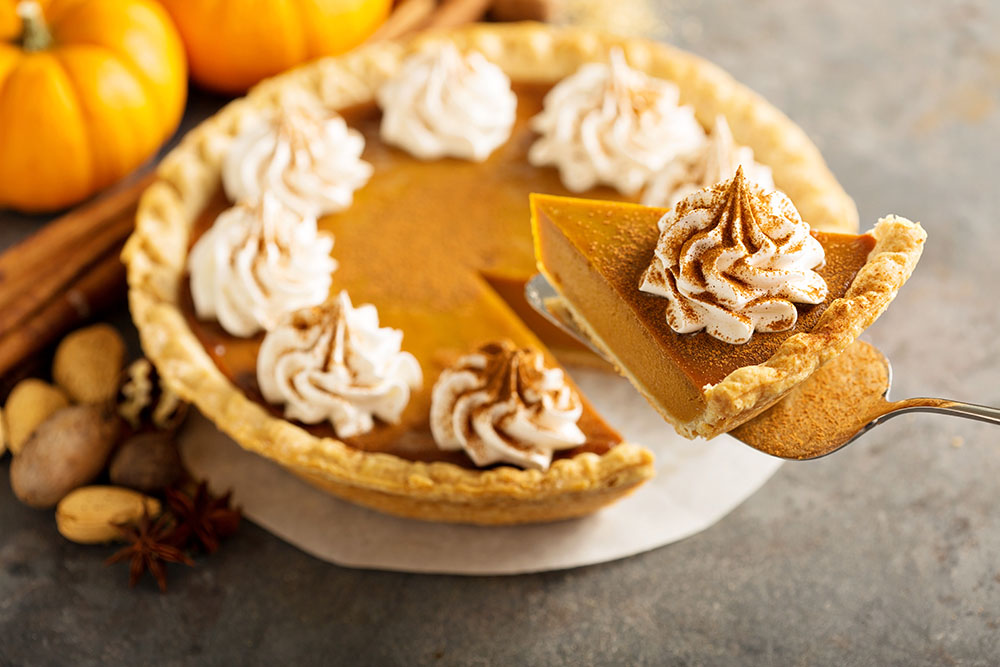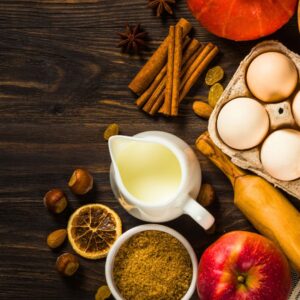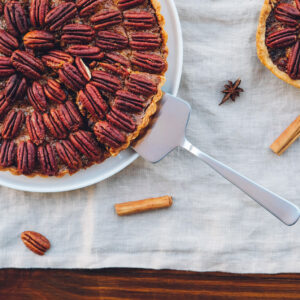Have you ever thought about the history behind pumpkin pie and who invented it? Its creation isn’t attributed to a single individual. The history of pumpkin pie is far more captivating. Let’s dive right in.

Have you ever thought about the history behind pumpkin pie and who invented it? Its creation isn’t attributed to a single individual. The history of pumpkin pie is far more captivating. Let’s dive right in.
Fall is For Pumpkins
Autumn in the United States is synonymous with the pumpkin, a food that is deeply ingrained in the season. It is during this time of the year that we are presented with the opportunity to indulge in everything pumpkin-flavored. From the obligatory fall beverage, the pumpkin spice latte, to pumpkin bread, muffins, cookies, soup, cake, pasta, and much more. However, the most celebrated of all pumpkin dishes, and also the oldest and most traditional, is the pumpkin pie.
This iconic dessert is a staple during both Thanksgiving and Christmas and is often considered as essential to the meal as the turkey itself. Adorned with a dollop of whipped cream, the pumpkin pie has become the epitome of holiday indulgence. Interestingly, the pumpkin is truly an all-American fruit.
The History of the Pumpkin
The pumpkin’s origins can be traced back to Central America, where it was cultivated by humans for hundreds of years. The ancient Americans held it in high regard, and for good reason. Its delectable taste was so irresistible that the first European explorers to the region brought it back to Europe on their earliest expeditions. The pumpkin made its first appearance in European writing in 1536, and Europeans quickly adopted it as their own. It became a widely grown crop in England and France by the mid-1500s, known as “pumpions” in England and “pompons” in France. The name was derived from the French word for the round part of a tassel in both languages.
When the English colonists arrived in New England in the early 1600s and brought pumpkins with them, the name gradually changed to “pumpkin” to fit the American vernacular within a few generations.
The History Behind The Pumpkin Pie
Before being brought back to America, the English were the first nation to use pumpkins in pies. England had a long-standing and specialized pie-making industry that had been in existence for centuries, even in the 1500s. Medieval pies were pastry shells filled with both sweet and savory fillings, and when pumpkins gained popularity in England, they were swiftly incorporated as a pie filling.
While many European countries used pumpkins in their cuisine after they were introduced from the New World, none embraced all things pumpkin quite like the English. Hence, when the Pilgrims sailed to New England in 1620, they were likely already familiar with pumpkins, much like the Native Americans they met upon their arrival at Plymouth. The Wampanoag tribe, in particular, played a crucial role in assisting the new colonists in surviving their first harsh winter in New England. Pumpkins, being an easily preserved food, were most likely one of the foods that the natives shared with the colonists during this period.
Pumpkins At The First Thanksgiving
Pumpkins were almost certainly present at the “first Thanksgiving” celebration, which was held after the colonists’ first harvest on American soil, following a harsh winter. The surviving colonists from the Mayflower were able to plant and cultivate crops on American soil with the help of the Native Americans, particularly the Wampanoag tribe. In recognition of their success in this new land, the colonists invited 90 of the local Wampanoag to their harvest celebration. Pumpkin was a crop that grew abundantly in the area and was already cultivated by the Wampanoag, making it highly probable that some form of pumpkin dish was served at the first Thanksgiving.
The Time The Pumpkin Was Nearly Forgotten
As New England prospered, the colonists started to rely more on familiar foods from England, which were regularly imported on incoming ships and began cultivating crops such as pears, apples, quince, and others. During the early stages of New England’s development, the colonists were already self-sufficient and eventually shifted away from pumpkins to other foods from home. However, they never completely disregarded the pumpkin.
The Origin of The Pumpkin Pie
Early versions of pumpkin pie in Europe and North America were quite different from the “traditional” pumpkin pie we know today. Sixteenth and seventeenth-century cookbooks often recommended boiling the pumpkin in milk before putting it in a flour crust, sometimes layering it with apples or seasoning it with savory herbs like rosemary, marjoram, and thyme. In early New England, settlers even used a recipe that involved hollowing out a pumpkin, filling it with sweetened and spiced milk, and boiling it before drinking directly from the gourd.
However, by the early 1700s, the classic sweetened and spiced pumpkin puree baked in a flour crust became a regional New England favorite, closely associated with Thanksgiving. Colchester, Connecticut, even postponed its Thanksgiving celebration in 1705 because of a temporary shortage of molasses to make pumpkin pies for the feast. By 1796, an American cookbook contained a pumpkin pie recipe nearly identical to what we eat today.
Pumpkin pie and Thanksgiving became so synonymous with New England culture that the southern states protested when Abraham Lincoln made Thanksgiving a national holiday in 1863, seeing it as an attempt to impose northern culture and values on the south. However, after the Civil War, pumpkin pie and Thanksgiving became popular nationwide, and recipes began appearing in national women’s magazines. The famous Libby canned pumpkin was introduced in 1929, simplifying the pie-making process for home cooks.
Despite its many variations over the centuries, pumpkin pie has remained a favorite of Europeans and those who colonized America from the time they first encountered the Native Americans cultivating it. The history of pumpkin pie is long and fascinating, and it’s worth taking a moment to appreciate its origins the next time you enjoy a slice.
Pumpkin Pie Recipe
Cook Time: 80 minutes
Serves: 8
Ingredients:
- 1 (15oz) canned pumpkin
- 2 large eggs + 1 yolk
- ¾ cup sugar
- 2 tsp Spice Station Silver Lake Pumpkin Pie Spice blend
- ½ tsp salt
- 1 cup half and half
Tools:
- Food processor
- 9″ Pie shell
- Large mixing bowl
Directions:
- Preheat oven to 350 degrees Fahrenheit. To make the Gingerbread Pie Crust click here.
- Set aside the pie crust.
- In a large mixing bowl, whisk together the canned pumpkin and eggs. Then add the sugar, pumpkin pie spice blend, salt, and half and half.
- Pour the filling into the pie crust and bake at 350 degrees Fahrenheit for about 1 hour.
- Allow the pie to cool completely before serving.
Chef’s Notes:
- Pumpkin Pie is traditionally served with vanilla ice cream or whipped cream.
- No one likes huge cracks across the top of their pumpkin pie. This occurs when you allow your pie to bake for too long. Instead, try removing it from the oven when it has just set. It will finish setting as it begins to cool down. But if you do end up with a crack across the top, you can simply cover it with a large dollop of whipped cream just prior to serving.

Have you ever thought about the history behind pumpkin pie and who invented it? Its creation isn’t attributed to a single individual. The history of pumpkin pie is far more captivating. Let’s dive right in.
Fall is For Pumpkins
Autumn in the United States is synonymous with the pumpkin, a food that is deeply ingrained in the season. It is during this time of the year that we are presented with the opportunity to indulge in everything pumpkin-flavored. From the obligatory fall beverage, the pumpkin spice latte, to pumpkin bread, muffins, cookies, soup, cake, pasta, and much more. However, the most celebrated of all pumpkin dishes, and also the oldest and most traditional, is the pumpkin pie.
This iconic dessert is a staple during both Thanksgiving and Christmas and is often considered as essential to the meal as the turkey itself. Adorned with a dollop of whipped cream, the pumpkin pie has become the epitome of holiday indulgence. Interestingly, the pumpkin is truly an all-American fruit.
The History of the Pumpkin
The pumpkin’s origins can be traced back to Central America, where it was cultivated by humans for hundreds of years. The ancient Americans held it in high regard, and for good reason. Its delectable taste was so irresistible that the first European explorers to the region brought it back to Europe on their earliest expeditions. The pumpkin made its first appearance in European writing in 1536, and Europeans quickly adopted it as their own. It became a widely grown crop in England and France by the mid-1500s, known as “pumpions” in England and “pompons” in France. The name was derived from the French word for the round part of a tassel in both languages.
When the English colonists arrived in New England in the early 1600s and brought pumpkins with them, the name gradually changed to “pumpkin” to fit the American vernacular within a few generations.
The History Behind The Pumpkin Pie
Before being brought back to America, the English were the first nation to use pumpkins in pies. England had a long-standing and specialized pie-making industry that had been in existence for centuries, even in the 1500s. Medieval pies were pastry shells filled with both sweet and savory fillings, and when pumpkins gained popularity in England, they were swiftly incorporated as a pie filling.
While many European countries used pumpkins in their cuisine after they were introduced from the New World, none embraced all things pumpkin quite like the English. Hence, when the Pilgrims sailed to New England in 1620, they were likely already familiar with pumpkins, much like the Native Americans they met upon their arrival at Plymouth. The Wampanoag tribe, in particular, played a crucial role in assisting the new colonists in surviving their first harsh winter in New England. Pumpkins, being an easily preserved food, were most likely one of the foods that the natives shared with the colonists during this period.
Pumpkins At The First Thanksgiving
Pumpkins were almost certainly present at the “first Thanksgiving” celebration, which was held after the colonists’ first harvest on American soil, following a harsh winter. The surviving colonists from the Mayflower were able to plant and cultivate crops on American soil with the help of the Native Americans, particularly the Wampanoag tribe. In recognition of their success in this new land, the colonists invited 90 of the local Wampanoag to their harvest celebration. Pumpkin was a crop that grew abundantly in the area and was already cultivated by the Wampanoag, making it highly probable that some form of pumpkin dish was served at the first Thanksgiving.
The Time The Pumpkin Was Nearly Forgotten
As New England prospered, the colonists started to rely more on familiar foods from England, which were regularly imported on incoming ships and began cultivating crops such as pears, apples, quince, and others. During the early stages of New England’s development, the colonists were already self-sufficient and eventually shifted away from pumpkins to other foods from home. However, they never completely disregarded the pumpkin.
The Origin of The Pumpkin Pie
Early versions of pumpkin pie in Europe and North America were quite different from the “traditional” pumpkin pie we know today. Sixteenth and seventeenth-century cookbooks often recommended boiling the pumpkin in milk before putting it in a flour crust, sometimes layering it with apples or seasoning it with savory herbs like rosemary, marjoram, and thyme. In early New England, settlers even used a recipe that involved hollowing out a pumpkin, filling it with sweetened and spiced milk, and boiling it before drinking directly from the gourd.
However, by the early 1700s, the classic sweetened and spiced pumpkin puree baked in a flour crust became a regional New England favorite, closely associated with Thanksgiving. Colchester, Connecticut, even postponed its Thanksgiving celebration in 1705 because of a temporary shortage of molasses to make pumpkin pies for the feast. By 1796, an American cookbook contained a pumpkin pie recipe nearly identical to what we eat today.
Pumpkin pie and Thanksgiving became so synonymous with New England culture that the southern states protested when Abraham Lincoln made Thanksgiving a national holiday in 1863, seeing it as an attempt to impose northern culture and values on the south. However, after the Civil War, pumpkin pie and Thanksgiving became popular nationwide, and recipes began appearing in national women’s magazines. The famous Libby canned pumpkin was introduced in 1929, simplifying the pie-making process for home cooks.
Despite its many variations over the centuries, pumpkin pie has remained a favorite of Europeans and those who colonized America from the time they first encountered the Native Americans cultivating it. The history of pumpkin pie is long and fascinating, and it’s worth taking a moment to appreciate its origins the next time you enjoy a slice.
Pumpkin Pie Recipe
Cook Time: 80 minutes
Serves: 8
Ingredients:
- 1 (15oz) canned pumpkin
- 2 large eggs + 1 yolk
- ¾ cup sugar
- 2 tsp Spice Station Silver Lake Pumpkin Pie Spice blend
- ½ tsp salt
- 1 cup half and half
Tools:
- Food processor
- 9″ Pie shell
- Large mixing bowl
Directions:
- Preheat oven to 350 degrees Fahrenheit. To make the Gingerbread Pie Crust click here.
- Set aside the pie crust.
- In a large mixing bowl, whisk together the canned pumpkin and eggs. Then add the sugar, pumpkin pie spice blend, salt, and half and half.
- Pour the filling into the pie crust and bake at 350 degrees Fahrenheit for about 1 hour.
- Allow the pie to cool completely before serving.
Chef’s Notes:
- Pumpkin Pie is traditionally served with vanilla ice cream or whipped cream.
- No one likes huge cracks across the top of their pumpkin pie. This occurs when you allow your pie to bake for too long. Instead, try removing it from the oven when it has just set. It will finish setting as it begins to cool down. But if you do end up with a crack across the top, you can simply cover it with a large dollop of whipped cream just prior to serving.



